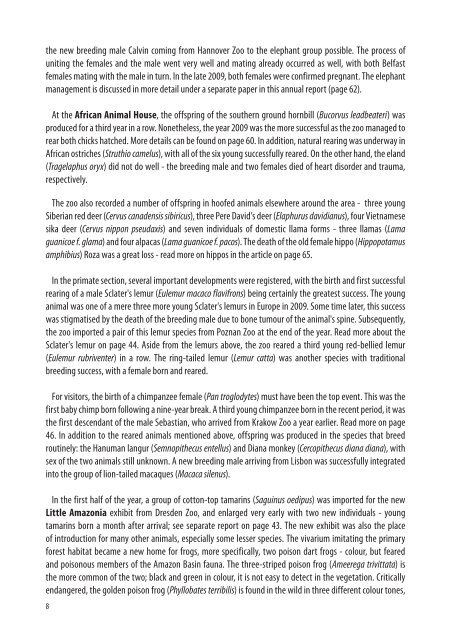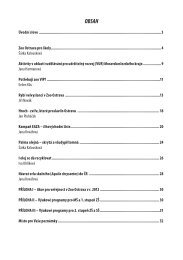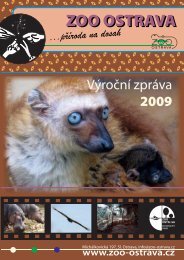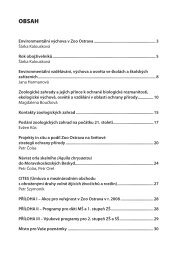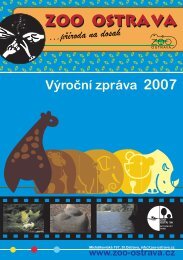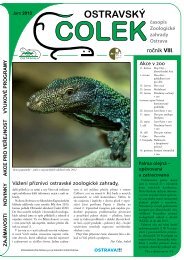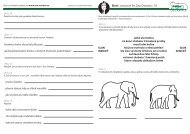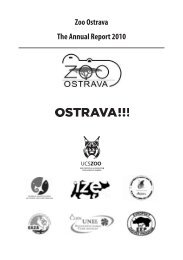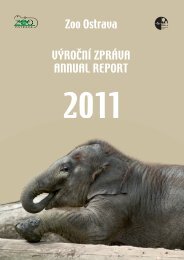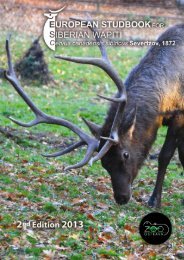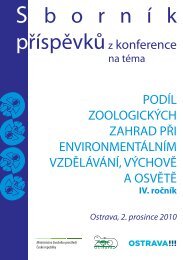You also want an ePaper? Increase the reach of your titles
YUMPU automatically turns print PDFs into web optimized ePapers that Google loves.
the new breeding male Calvin coming from Hannover <strong>Zoo</strong> to the elephant group possible. <strong>The</strong> process of<br />
uniting the females and the male went very well and mating already occurred as well, with both Belfast<br />
females mating with the male in turn. In the late <strong>2009</strong>, both females were confirmed pregnant. <strong>The</strong> elephant<br />
management is discussed in more detail under a separate paper in this annual report (page 62).<br />
At the African Animal House, the offspring of the southern ground hornbill (Bucorvus leadbeateri) was<br />
produced for a third year in a row. Nonetheless, the year <strong>2009</strong> was the more successful as the zoo managed to<br />
rear both chicks hatched. More details can be found on page 60. In addition, natural rearing was underway in<br />
African ostriches (Struthio camelus), with all of the six young successfully reared. On the other hand, the eland<br />
(Tragelaphus oryx) did not do well - the breeding male and two females died of heart disorder and trauma,<br />
respectively.<br />
<strong>The</strong> zoo also recorded a number of offspring in hoofed animals elsewhere around the area - three young<br />
Siberian red deer (Cervus canadensis sibiricus), three Pere David’s deer (Elaphurus davidianus), four Vietnamese<br />
sika deer (Cervus nippon pseudaxis) and seven individuals of domestic llama forms - three llamas (Lama<br />
guanicoe f. glama) and four alpacas (Lama guanicoe f. pacos). <strong>The</strong> death of the old female hippo (Hippopotamus<br />
amphibius) Roza was a great loss - read more on hippos in the article on page 65.<br />
In the primate section, several important developments were registered, with the birth and first successful<br />
rearing of a male Sclater's lemur (Eulemur macaco flavifrons) being certainly the greatest success. <strong>The</strong> young<br />
animal was one of a mere three more young Sclater's lemurs in Europe in <strong>2009</strong>. Some time later, this success<br />
was stigmatised by the death of the breeding male due to bone tumour of the animal's spine. Subsequently,<br />
the zoo imported a pair of this lemur species from Poznan <strong>Zoo</strong> at the end of the year. Read more about the<br />
Sclater's lemur on page 44. Aside from the lemurs above, the zoo reared a third young red-bellied lemur<br />
(Eulemur rubriventer) in a row. <strong>The</strong> ring-tailed lemur (Lemur catta) was another species with traditional<br />
breeding success, with a female born and reared.<br />
For visitors, the birth of a chimpanzee female (Pan troglodytes) must have been the top event. This was the<br />
first baby chimp born following a nine-year break. A third young chimpanzee born in the recent period, it was<br />
the first descendant of the male Sebastian, who arrived from Krakow <strong>Zoo</strong> a year earlier. Read more on page<br />
46. In addition to the reared animals mentioned above, offspring was produced in the species that breed<br />
routinely: the Hanuman langur (Semnopithecus entellus) and Diana monkey (Cercopithecus diana diana), with<br />
sex of the two animals still unknown. A new breeding male arriving from Lisbon was successfully integrated<br />
into the group of lion-tailed macaques (Macaca silenus).<br />
In the first half of the year, a group of cotton-top tamarins (Saguinus oedipus) was imported for the new<br />
Little Amazonia exhibit from Dresden <strong>Zoo</strong>, and enlarged very early with two new individuals - young<br />
tamarins born a month after arrival; see separate report on page 43. <strong>The</strong> new exhibit was also the place<br />
of introduction for many other animals, especially some lesser species. <strong>The</strong> vivarium imitating the primary<br />
forest habitat became a new home for frogs, more specifically, two poison dart frogs - colour, but feared<br />
and poisonous members of the Amazon Basin fauna. <strong>The</strong> three-striped poison frog (Ameerega trivittata) is<br />
the more common of the two; black and green in colour, it is not easy to detect in the vegetation. Critically<br />
endangered, the golden poison frog (Phyllobates terribilis) is found in the wild in three different colour tones,<br />
8


